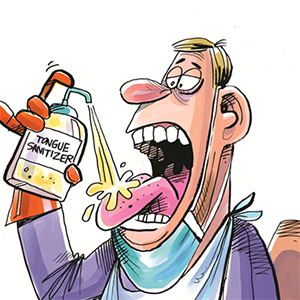Baltimore Key Bridge collapse case caught up in legal blame game
Published in News & Features
BALTIMORE — Attorneys involved in the sprawling civil case stemming from the Key Bridge collapse traded barbs Tuesday about the March 26 disaster at a hearing called to figure out how to resolve such a complicated legal matter.
William Bennett, an attorney for the Singaporean companies that own and manage the 984-foot, 100,000-ton container ship named Dali that toppled the bridge, said there was “significant liability and fault by the State of Maryland” in the deadly disaster because the state “failed to protect the bridge, knowing its vulnerabilities.”
He also said Hyundai Heavy Industries, the Korean company that manufactured the ship, bears some responsibility in the collapse that killed six construction workers and seriously injured a seventh, suggesting Hyundai built an electrical system that malfunctioned as the ship approached the 1.6-mile span.
Both Maryland’s and Hyundai’s roles in the disaster, Bennett argued, should be considered at a trial during which U.S. District Judge James K. Bredar will decide whether to absolve Grace Ocean Private Ltd. and Synergy Marine Ltd., the owner and manager of the Dali, of liability related to the collapse.
Not a week after the bridge fell, while emergency responders were still working to recover workers’ bodies from the water and remove the tangled mess of steel and concrete from the shipping channel, the Singaporean companies cited a 19th century law to limit or free themselves of liability in the crash.
The Justice Department, Maryland, Baltimore, the families of the fallen workers and businesses affected by the collapse subsequently sued Grace Ocean and Synergy Marine, arguing they should be held fully responsible for the crash, because they to allowed an unseaworthy vessel to set sail.
There have been 46 lawsuits filed against the Singaporean companies to date in the civil case, with the Justice Department having settled its explosive claim for $100 million last week.
In court Tuesday, lawyers for those suing Grace Ocean and Synergy Marine said the forthcoming trial should focus on those companies’ actions alone.
David Reisman, an attorney hired to represent Maryland, said his legal team “spent months with a team of international experts,” including 10 days aboard the Dali, analyzing the ship’s systems.
“What we found was, frankly, shocking conduct that completely disregarded safety,” Reisman said.
In its lawsuit, Maryland accused the companies of pressuring their crew to make shoddy fixes to limit vibrations to its transformer, a critical component of the ship’s electrical system. It also alleged the crew failed to disclose previous power outages, “falsely” assuring local Maryland pilots that “everything was in good working order” before the doomed voyage on March 26.
The Dali lost power twice roughly 10 hours before it left the Port of Baltimore’s Seagirt Marine Terminal early that morning, according to a report from the National Transportation Safety Board, which is investigating the disaster. The in-port blackouts led the ship’s crew to switch breakers to the vessel’s electrical system.
Those replacement breakers tripped after it departed, causing the first of two complete power losses aboard the ship within about a half a mile of the bridge, rendering it adrift. When announcing the lawsuit, Maryland Democratic Attorney General Anthony Brown described the Dali as “a dark missile, gliding through the port until it struck a pier of the Key Bridge with catastrophic force.”
Maryland’s lawsuit seeks a range of damages: part of the cleanup, the estimated $1.7 billion it will cost to erect a new bridge; lost toll revenues while the bridge is down; environmental damage to state waters; and increased “wear and tear” on local roads from travelers who would’ve traversed the bridge.
Bredar ordered the case split into two phases, with the first to determine whether Grace Ocean and Synergy Marine’s liability will be limited or exonerated, and the second to determine damages for those who filed lawsuits.
Bredar estimated that more than 99% of maritime cases are settled before there are trials on damages. He suggested this case is poised for a trial on limitation of liability, which he estimated would take place in early 2026 and span 15 days.
Experts have told The Baltimore Sun the legal question of limiting liability boils down to whether the Singaporean companies had “privity and knowledge” of problems aboard the ship before it set sail.
There were at least three dozen lawyers present in court Tuesday in the largest courtroom in Baltimore’s U.S. District Court, with many more attorneys likely involved in the case than were in attendance.
Bredar ordered several lawyers to lead groups of those with claims in the case. He split the groups of claims into personal injury and wrongful death, property damage, local governments, cargo and private economic loss.
“We are here because of six families that were forever destroyed, shattered,” said Daniel Rose, an attorney chosen to lead others with claims on behalf of bridge collapse victims.
The victims worked for Brawner Builders Inc. construction crew that was filling potholes on the bridge the morning the ship struck. Maynor Yasir Suazo Sandoval, Miguel Angel Luna, Jose Mynor Lopez, Dorlian Ronial Castillo Cabrera, Alejandro “Alex” Hernandez Fuentes and Carlos Daniel Hernandez Estrella died in the collapse. It took weeks for authorities to recover them from the wreckage.
Julio Cervantes Suarez, who also worked for Brawner, survived the collapse by escaping from a sinking truck and clinging to a piece of concrete until he could be rescued.
In court, Bredar noted that maritime law is “not charitable” to economic losses. A publishing company and propane business are among those who have filed in the case, claiming that their bottom lines suffered because of the collapse. Experts previously told The Sun that it is difficult to recover money without physical damage to a claimant’s property.
Should Bredar exclude them from recovering damages, the businesses who filed for economic losses are prepared to appeal their cases all the way up to the Supreme Court, said Todd Lochner, an attorney chosen to lead them.
“The Dali is going to be the vessel with which we rewrite maritime law. Is that the hope?” Bredar asked.
Lochner said it was.
_________
©2024 The Baltimore Sun. Visit at baltimoresun.com. Distributed by Tribune Content Agency, LLC.







Comments